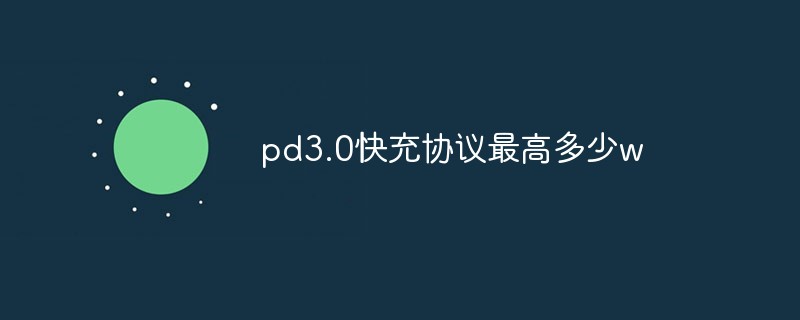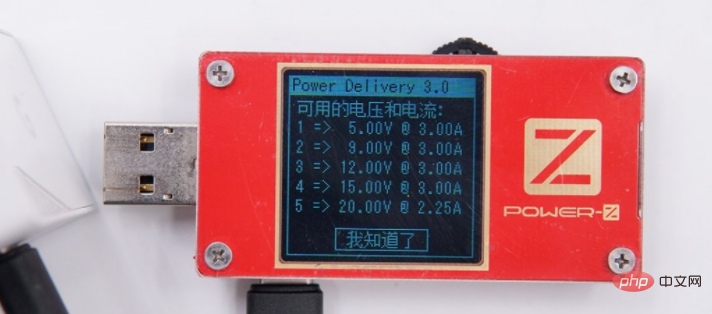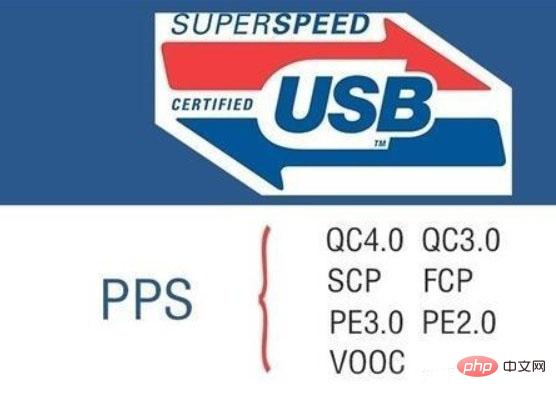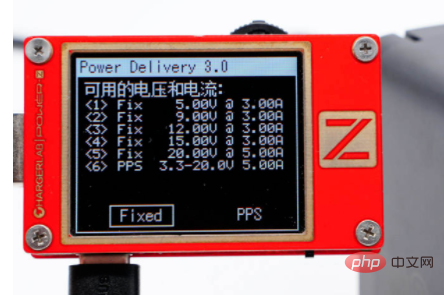What is the maximum watt of PD3.0 fast charging protocol?
pd3.0 fast charging protocol supports up to “100W”. In November 2015, USB PD fast charging ushered in a major version update, entering the era of USB PD3.0 fast charging; the PD3.0 protocol supports 5V3A, 9V3A, 12V3A, 15V3A, 20V5A output, and the maximum power can reach 100W. Not only can It can be used to charge mobile phones, and can also be used to power laptops or monitors.

The operating environment of this tutorial: HarmonyOS 2 system, HONOR V30 mobile phone.
PD fast charging protocol
The full name is "USB Power Delivery" power transmission protocol, referred to as "PD protocol"
In November 2015, USB PD fast charging received a major version update, entering the USB PD3.0 fast charging era. There are three main changes in USB PD3.0 compared to USB PD2.0: a more detailed description of the device's built-in battery characteristics is added; the function of device software and hardware version identification and software update through PD communication is added, and the number Certificate and digital signature functions.

PD3.0 protocol supports 5V3A, 9V3A, 12V3A, 15V3A, 20V5A output. The maximum power can reach 100W. It can be used not only for charging mobile phones, but also for laptops. Or the monitor supplies power; currently, if you see laptops using Type-C interface charging cables, they basically use the PD protocol, and there are still relatively few monitors.
PD 3.0 protocol adds a specification called PPS specification
PPS specification: Programmable Power Supply, Google requires that the fast charging protocol installed on mobile phones above Android 7.0 must be Support PD protocol.
PD3.0 protocol already includes Qualcomm QC 3.0 and 4.0, Huawei's SCP and FCP, MTK's PE3.0 and PE2.0, and OPPO's VOOC and other protocols. PD 3.0 supports up to 100W charging power and is backward compatible. Thanks to its compatibility with multiple protocols, for example, if we have iPhones, Android phones, laptops, and game consoles, we can all use a PD3.0 The charging head of the agreement is ready.
PD3.0 is backward compatible with PD2.0 and PD1.0

##Extended knowledge:
1. USB PD3.0 PPS
In order to change the situation of fragmentation and fragmentation of fast charging protocols in the mobile phone market, the USB-IF Association released in February 2017 An important update to the USB PD3.0 standard, a programmable power supply PPS is added to the USB PD3.0 standard.
2. USB PD3.1
USB PD3.1 is the fast charging standard just released by the USB-IF Association. The USB PD3.1 fast charging standard is actually Update based on USB PD3.0 PPS fast charging.
FAQ column!
The above is the detailed content of What is the maximum watt of PD3.0 fast charging protocol?. For more information, please follow other related articles on the PHP Chinese website!

Hot AI Tools

Undresser.AI Undress
AI-powered app for creating realistic nude photos

AI Clothes Remover
Online AI tool for removing clothes from photos.

Undress AI Tool
Undress images for free

Clothoff.io
AI clothes remover

Video Face Swap
Swap faces in any video effortlessly with our completely free AI face swap tool!

Hot Article

Hot Tools

Notepad++7.3.1
Easy-to-use and free code editor

SublimeText3 Chinese version
Chinese version, very easy to use

Zend Studio 13.0.1
Powerful PHP integrated development environment

Dreamweaver CS6
Visual web development tools

SublimeText3 Mac version
God-level code editing software (SublimeText3)

Hot Topics
 1393
1393
 52
52
 1206
1206
 24
24
 Which protocol does vivo fast charging belong to?
Sep 06, 2022 pm 02:43 PM
Which protocol does vivo fast charging belong to?
Sep 06, 2022 pm 02:43 PM
There are two main protocols for vivo fast charging: 1. "QC 2.0" fast charging protocol. "QC2.0" is "Quick Charge 2.0" technology. It is version 2.0 of fast charging technology released by Qualcomm. It can output 5V, 9V, and 12V. , 20V four voltage groups; 2. PD fast charging protocol is a fast charging specification formulated by the "USB-IF" organization. It is one of the current mainstream fast charging protocols and can make the current default maximum power "5V/2A" The "type-c" interface is increased to 100W.
 What is the maximum watt of PD3.0 fast charging protocol?
Nov 08, 2022 pm 04:04 PM
What is the maximum watt of PD3.0 fast charging protocol?
Nov 08, 2022 pm 04:04 PM
The PD3.0 fast charging protocol supports up to “100W”. In November 2015, USB PD fast charging ushered in a major version update, entering the USB PD3.0 fast charging era; the PD3.0 protocol supports 5V3A, 9V3A, 12V3A, 15V3A, 20V5A output, and the maximum power can reach 100W. Not only can It can be used to charge mobile phones, and can also be used to power laptops or monitors.
 What are the 5 industrial communication protocols?
Sep 28, 2022 am 11:52 AM
What are the 5 industrial communication protocols?
Sep 28, 2022 am 11:52 AM
5 types of industrial communication protocols: 1. Modbus protocol, which is a universal language used in electronic controllers; 2. RS-232 protocol, which is a serial physical interface standard; 3. RS-485 protocol, which is based on RS232 Developed on the basis of; 4. HART protocol is a communication protocol used between on-site intelligent instruments and control room equipment; 5. MPI protocol is a cross-language communication protocol used to write parallel computers.
 SOAP Protocol Guide in PHP
May 20, 2023 pm 07:10 PM
SOAP Protocol Guide in PHP
May 20, 2023 pm 07:10 PM
With the continuous development of Internet technology, more and more enterprise-level applications need to provide interfaces to other applications to realize the interaction of data and business. In this case, we need a reliable protocol to transmit data and ensure data integrity and security. SOAP (Simple Object Access Protocol) is an XML-based protocol that can be used to implement communication between applications in a Web environment. As a popular web programming language, PHP
 What is the qc4+ fast charging protocol?
Aug 18, 2022 pm 03:49 PM
What is the qc4+ fast charging protocol?
Aug 18, 2022 pm 03:49 PM
The QC4+ fast charging protocol is a combination of the USB PD PPS protocol and the QC3.0/2.0 fast charging protocol. It is a multi-functional, multi-protocol fast charging technology. The QC4+ charging protocol is compatible with USB PD3.0 (PPS) and is downwardly compatible with USB PD2.0, QC3.0, QC2.0, BC1.2 and other protocols. The first prerequisite for supporting USB PD and QC4+ is the support of USB-C interfaces at both ends and the power negotiation message based on the CC (configuration channel) in the USB-C interface.
 What technology does the x.25 protocol use?
Jul 18, 2022 pm 04:05 PM
What technology does the x.25 protocol use?
Jul 18, 2022 pm 04:05 PM
The "x.25" protocol uses packet switching technology; the "x.25" protocol is a computer-oriented data communication network, consisting of basic equipment such as transmission lines, packet switches, remote concentrators and packet terminals, and adopts a layered architecture , negotiation, control and information transmission of information exchange are carried out between the peer layers of the interface through the communication protocol between the peer layers.
 Windows will retire TLS 1.0 and TLS 1.1 in the near future
Aug 12, 2023 am 11:37 AM
Windows will retire TLS 1.0 and TLS 1.1 in the near future
Aug 12, 2023 am 11:37 AM
Microsoft plans to disable Transport Layer Security (TLS) protocol versions 1.0 and 1.1 in Windows. The company announced the news on its technology community website on March 1, 2023. These two protocols date back to 1999 (TLS1.0) and 2006 (TLS1.1) and have since been surpassed by newer versions TLS1.2 and TLS1.3. Microsoft noted that security issues were discovered in older protocol versions, and "Internet standards and regulators have deprecated or disallowed TLS versions 1.0 and 1.1 in response. Over the years, usage of TLS 1.0 and 1.1 has declined significantly. , Microsoft believes the time has come to disable both protocols. Mic
 Python Programming: Easily Understand Context Manager (Context Manager)
Apr 12, 2023 pm 02:07 PM
Python Programming: Easily Understand Context Manager (Context Manager)
Apr 12, 2023 pm 02:07 PM
Preface This article focuses on the explanation and application of Python's context management. Or through code examples, comparative understanding and learning, in order to achieve the understanding, mastery and application of "more speed, better economy". Without further ado, let’s start - 1. What is a context manager? A context manager is an object that defines the runtime context to be established when executing a with statement. A context manager is a runtime that automatically handles entry and exit for the context in which a block of code executes. Context managers are typically called using a with statement, but can also be used by calling their methods directly. Typical uses of context managers include saving and restoring various global states, locking and unlocking resources, closing open files, and so on. In this chapter we will learn how to



